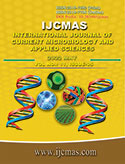


 National Academy of Agricultural Sciences (NAAS)
National Academy of Agricultural Sciences (NAAS)

|
PRINT ISSN : 2319-7692
Online ISSN : 2319-7706 Issues : 12 per year Publisher : Excellent Publishers Email : editorijcmas@gmail.com / submit@ijcmas.com Editor-in-chief: Dr.M.Prakash Index Copernicus ICV 2018: 95.39 NAAS RATING 2020: 5.38 |
India is a country that has major dependence on agriculture. In spite of all the careful measures, there is a loss of agricultural land due to improper use of land. One way to tackle the issue is hand, is by monitoring and quantifying the crop. Also, Crop discrimination and Acreage estimation are essential for planning and policymaking at various administrative levels. In earlier days, a field-based survey was executed with meddlesome factors like time consumption, and labor-intensive. But with remote sensing and GIS technology in the picture, the survey became a cakewalk. It can provide timely and accurate crop inventory information. Also, with a focus on Machine Learning in recent years, crop classification became more precise. The main objective of this study is to evaluate the performance of Maximum Likelihood Classification (MLC), Minimum Distance to Mean classification (MDMC), Support Vector Machine (SVM) classification, and Neural Net (NN) classification for crop discrimination and acreage estimation in Veppanthattai Block of Perambalur District in Tamil Nadu using Sentinel 2B. Ground truth data were collected randomly over the study area, in that 60% of data used for training and 40% data was used for testing the classification. It was inferred that MLC was the best with a kappa coefficient of 0.89, compared with MDMC, SVM, and NN which exhibited poor classification results with a kappa coefficient of 0.47, 0.85, and 0.83 respectively.
 |
 |
 |
 |
 |